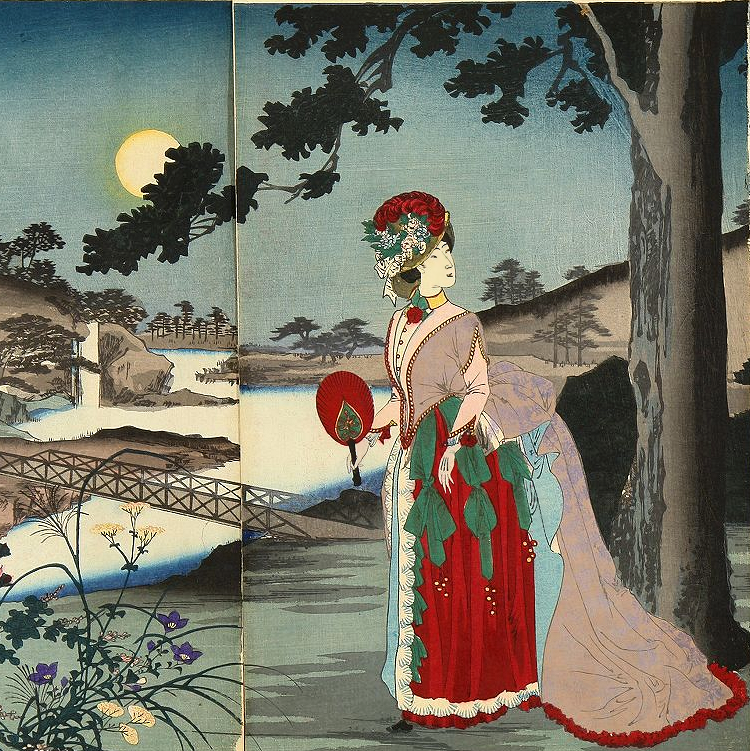 |
| "Illustration of Flowering Cherry Blossoms at Ueno Park." (Right-hand plate.) |
 |
| "Illustration of Flowering Cherry Blossoms at Ueno Park." |
The politics of Japan - both internal and international - were complicated and very troubled at the time of the Meiji Emperor's accession in 1867. According to the
Nihon Shoki,
the classical history of Japan, the nation has had an emperor since 660 BC, but for almost seven hundred years prior to the Meiji Restoration, Japan was actually controlled by a Shogunate, the emperors revered but virtually powerless. But with the forced opening of trade with the United States in the 1850s, the old systems of government had proved unequal to Western aggression, and the power of the Shogun was under attack. Finally, in 1868, after more than a decade of unrest, the new Emperor - still only fifteen years old - made a formal declaration of the restoration of his power, a restoration of practical imperial rule in Japan. In the following years, he oversaw radical changes in the country's political, military, and social structures, as Japan transformed itself from a feudal and isolationist society into a modern international power.
 |
| "A Mirror of Japan’s Nobility - The Emperor Meiji, His Wife, and Prince Haru." |
Chikanobu's images of the Emperor, the Empress, and ladies of the Imperial court are a vivid example of the ruler's push to Westernize Japan. Court dress and uniforms for men, based on European models, were decreed only three years after the Restoration. Soon, too, fashionable, upper-class ladies, inspired by the Empress, took up wearing Western dress in public. And in 1886 - just prior to the images here - the court set out rules for ladies' formal wear. (None of these examples are of formal wear.) Ironically, Chikanobu, who so brilliantly described the lavish European fashion in his work here, came to greatly regret the changes in his country, the ever-escalating Westernization, the loss of its traditional culture.
 |
| "Blooming Chrysanthemums in an Autumn Garden." |
 |
| "Excursion to View Cherry Blossoms by the Sumida River." |
 |
| "Meiji Emperor, Empress, Crown Prince, and Court Attendants in Western Clothing." |
 |
| "Meiji Emperor Prepares to Leave the Palace in the Phoenix Carriage." |
 |
| "Meiji Emperor and Empress - Autumn Colors." |
 |
| "Illustration of the Garden Refreshed after the Rain." |
 |
| "A Scene of the Japanese Diet." |
 |
| "A Contest of Elegant Ladies among the Cherry Blossoms." |
 |
| "Children Playing in the Snow under Plum Trees in Bloom." |
 |
| "Procession Outside Tokyo Imperial Palace with Meiji Emperor and his Consort." |
 |
| "Meiji Constitution Promulgation." |
 |
| "The Emperor, Empress, Crown Prince, and Court Ladies on an Outing to Asuka Park." |
 |
| "Illustration of Singing by the Plum Garden." |
 |
| "Visit of the Empress to the Third National Industrial Promotional Exhibition at Ueno Park." |
 |
| "Meiji Emperor, Empress, Crown Prince, and Court Attendants in Western Clothing/Royal Couple with Chrysanthemums." |
 |
| "The Emperor Enjoys A Cool Evening." |
***
Toyohara Chikanobu (豊原周延, better known to his contemporaries as Yōshū Chikanobu 楊洲周延, the name with which he signed his work: 1838–1912), woodblock artist of Japan's Meiji period. Born in Niigata Prefecture as Hashimoto Naoyoshi (橋本直義), he was the eldest of two children, his father a retainer of the powerful Sakakibara clan of samurai in Echigo Province. He showed artistic abilities as a young child and was given lessons with respected teachers. He also trained in the martial arts, and after the collapse of the Tokugawa Shogunate, he joined the
Shōgitai, an elite fighting corps, and became famous for his bravery in battle. In 1871, three years into the Meiji era, he established himself in Tokyo as a professional artist. He had studied several genres of art making, but was most drawn to
ukiyo-e. His subject matter displayed great variety, ranging from Japanese mythology to battle scenes to ladies' fashions, from scenes of natural disasters to actor portraits. He illustrated events both contemporary and historical. He was very successful, but by the last decade of the century, he and much of his audience were becoming dismayed by the rapid changes taking place in Tokyo and were increasingly nostalgic about the lost world of the Shogunate, and his later work reflects this nostalgia. His last works featured retrograde images of the brave samurai and heroic women of Japan's past, and by 1905 his production of work had dwindled. He died of stomach cancer at the age of seventy-five.
































































